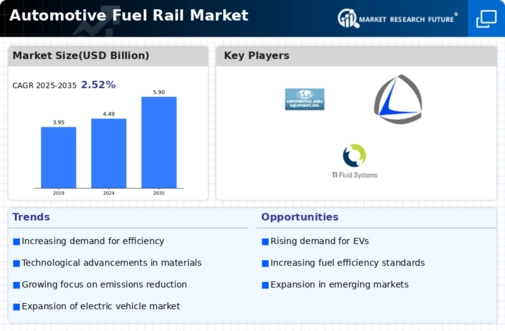Market Share
Automotive Fuel Rail Market Share Analysis
The automotive fuel rail market has been boosted by great changes and innovations, being a kind of manifestation of dynamism in the whole sector. One of the key trends is the developing tendency for fuel economy and pollutants level to be reduced in compliance with ever tightening environmental standards and this sensitive topic of sustainability. Nowadays, more and more manufacturers take advantage of the highly advanced fuel-rail technology for the purpose of carving out competitive edges through the improvement of fuel supply systems in vehicles. However, considering electronic fuel injectors (EFI) systems incorporation as well as light weight materials in fuel rail construction this can contribute to overall vehicle weight decrease and driving fuel economy.
Another massive aspect guiding the auto fuel rail market is that electric and hybrid vehicles' demand for alternative fuel is increasing. Facades along the road, which were symbolic of dramatic urban changes, not only served as reminders of the electrification process but also displayed the status of the city as progressive and forward-thinking. The consequent influence of this change is apparent in the overall precision rail market because electric cars do not require such traditional fuel injection systems. While the market, in response, is keen in embracing hydrogen fuel cells and similar technologies as alternatives, fuel rail systems’ applications are becoming more diverse given a major demand shift in automotive necessities.
Moreover, new technological improvements in fuel lines (i.e., design and the manufacturing methods) trigger market development. Advanced technologies such as 3D printing and sophisticated manufacturing techniques enables designers to come up with complex and lightweight improvements on fuel rail that were previously considered difficult or even impossible. This also goes a long way in making the fuel-efficient engines and this in turn towards meeting the manufacturing goals of keeping operations sustainable and cost-effective.
The second factor behind the shaping of fuel rail in automotive industry is globalization and interconnectedness among particular markets. Manufacturers of all sizes are seeking to achieve a greater market reach through effective strategies such as joint ventures, partnerships and incorporations. This phenomenon is the result of a drive for a geographic diversity of footprints in order to both address of consumers’ colorful needs and to comply with the regional laws. Consequently, the partnership will enable companies with the opportunity to apply the other's strong areas in technology, research and development, in order to jointly enhance the fuel rail systems' innovative level.






Leave a Comment